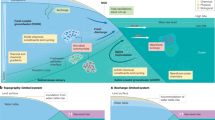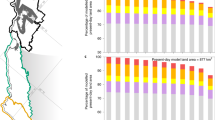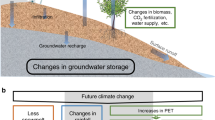Abstract
Climate change and human population growth are expected to have substantial impacts on global water resources throughout the twenty-first century1,2. Coastal aquifers are a nexus3 of the world’s oceanic and hydrologic ecosystems and provide a water source for the more than one billion people living in coastal regions4,5. Saltwater intrusion caused by excessive groundwater extraction is already impacting diverse regions of the globe5,6,7. Synthesis studies8,9 and detailed simulations10,11,12,13 have predicted that rising sea levels could negatively impact coastal aquifers through saltwater intrusion and/or inundation of coastal regions. However, the relative vulnerability of coastal aquifers to groundwater extraction and sea-level rise has not been systematically examined. Here we show that coastal aquifers are more vulnerable to groundwater extraction than to predicted sea-level rise under a wide range of hydrogeologic conditions and population densities. Only aquifers with very low hydraulic gradients are more vulnerable to sea-level rise and these regions will be impacted by saltwater inundation before saltwater intrusion. Human water use is a key driver in the hydrology of coastal aquifers, and efforts to adapt to sea-level rise at the expense of better water management are misguided.
This is a preview of subscription content, access via your institution
Access options
Subscribe to this journal
Receive 12 print issues and online access
$209.00 per year
only $17.42 per issue
Buy this article
- Purchase on Springer Link
- Instant access to full article PDF
Prices may be subject to local taxes which are calculated during checkout




Similar content being viewed by others
Change history
16 April 2012
In the version of this Letter originally published online, equation (1) was incorrect. This has now been corrected in all versions of the Letter.
References
Milly, P. C. D., Dunne, K. A. & Vecchia, A. V. Global pattern of trends in streamflow and water availability in a changing climate. Nature 438, 347–350 (2005).
Vorosmarty, C. J., Green, P., Salisbury, J. & Lammers, R. B. Global water resources: Vulnerability from climate change and population growth. Science 289, 284–288 (2000).
Moore, W. S. Large groundwater inputs to coastal waters revealed by 226Ra enrichments. Nature 380, 612–614 (1996).
Small, C. & Nicholls, R. J. A global analysis of human settlement in coastal zones. J. Coast. Res. 19, 584–599 (2003).
Post, V. E. A. Fresh and saline groundwater interaction in coastal aquifers: Is our technology ready for the problems ahead? Hydrogeol. J. 13, 120–123 (2005).
FitzGerald, D. M., Fenster, M. S., Argow, B. A. & Buynevich, I. V. Coastal impacts due to sea-level rise. Annu. Rev. Earth Planet. Sci. 36, 601–647 (2008).
Barlow, P. & Reichard, E. Saltwater intrusion in coastal regions of North America. Hydrogeol. J. 18, 247–260 (2010).
IPCC Climate Change 2007: The Physical Science Basis (eds Solomon, S. et al.) (Cambridge Univ. Press, 2007).
EPA National Water Program Strategy: Response to Climate Change 97 (EPA Office of Water, 2008).
Masterson, J. P. & Garabedian, S. P. Effects of sea-level rise on ground water flow in a coastal aquifer system. Ground Wat. 45, 209–217 (2007).
Webb, M. D. & Howard, K. W. F. Modeling the transient response of saline intrusion to rising sea-levels. Ground Wat. 49, 560–569 (2011).
Werner, A. D. & Simmons, C. T. Impact of sea-level rise on sea water intrusion in coastal aquifers. Ground Wat. 47, 197–204 (2009).
Loáiciga, H. A., Pingel, T. J. & Garcia, E. S. Sea water intrusion by sea-level rise: Scenarios for the 21st century. Ground Wat. 50, 37–47 (2012).
Postel, S. L., Daily, G. C. & Ehrlich, P. R. Human appropriation of renewable fresh water. Science 271, 785–788 (1996).
Rodell, M., Velicogna, I. & Famiglietti, J. S. Satellite-based estimates of groundwater depletion in India. Nature 460, 999–1002 (2009).
Wada, Y. et al. Global depletion of groundwater resources. Geophys. Res. Lett. 37, L20402 (2010).
Strack, O. D. L. A single-potential solution for regional interface problems in coastal aquifers. Wat. Resour. Res. 12, 1165–1174 (1976).
Gleeson, T., Marklund, L., Smith, L. & Manning, A. H. Classifying the water table at regional to continental scales. Geophys. Res. Lett. 38, L05401 (2011).
CIESIN Gridded Population of the World Version 3 (GPWv3): Population Density Grids (Socioeconomic Data and Applications Center, 2005); available at http://sedac.ciesin.columbia.edu/gpw.
Fan, Y., Miguez-Macho, G., Weaver, C. P., Walko, R. & Robock, A. Incorporating water table dynamics in climate modeling: 1. Water table observations and equilibrium water table simulations. J. Geophys. Res. 112, D10125 (2007).
USDA-NRCS, USGS & EPA Watershed Boundary Dataset for the United States (2010); available at http://datagateway.nrcs.usda.gov.
Wessel, P. & Smith, W. H. F. A global, self-consistent, hierarchical, high-resolution shoreline database. J. Geophys. Res. 101, 8741–8743 (1996).
Sanford, W. & Pope, J. Current challenges using models to forecast seawater intrusion: Lessons from the eastern shore of Virginia, USA. Hydrogeol. J. 18, 73–93 (2010).
Gleeson, T. et al. Mapping permeability over the surface of the Earth. Geophys. Res. Lett. 38, L02401 (2011).
Reilly, T. E. & Goodman, A. S. Analysis of saltwater upconing beneath a pumping well. J. Hydrol. 89, 169–204 (1987).
Gleick, P. H. et al. The World’s Water 2008–2009: The Biennial Report on Freshwater Resources (Island, 2009).
Döll, P. Vulnerability to the impact of climate change on renewable groundwater resources: A global-scale assessment. Environ. Res. Lett. 4, 035006 (2009).
Anderson, W. P. Jr Aquifer salinization from storm overwash. J. Coast. Res. 18, 413–420 (2002).
Vorosmarty, C. J. et al. Global threats to human water security and river biodiversity. Nature 467, 555–561 (2010).
Rockstrom, J. et al. A safe operating space for humanity. Nature 461, 472–475 (2009).
Acknowledgements
M. Jellinek, L. Smith, E. Luijendijk, V. Bense and V. Gerard provided valuable advice during the writing of this manuscript. Y. Fan generously provided data on the water-table elevation. T.G. was supported by the Natural Sciences and Engineering Research Council of Canada postdoctoral fellowship and a Canadian Institute for Advanced Research junior fellowship.
Author information
Authors and Affiliations
Contributions
Both authors contributed to planning of this paper. G.F. carried out the analytical modelling and T.G. conducted the GIS analyses. Both authors contributed to the writing of the paper and drafting of figures.
Corresponding author
Ethics declarations
Competing interests
The authors declare no competing financial interests.
Supplementary information
Rights and permissions
About this article
Cite this article
Ferguson, G., Gleeson, T. Vulnerability of coastal aquifers to groundwater use and climate change. Nature Clim Change 2, 342–345 (2012). https://doi.org/10.1038/nclimate1413
Received:
Accepted:
Published:
Issue Date:
DOI: https://doi.org/10.1038/nclimate1413
This article is cited by
-
The impacts of climate change on coastal groundwater
Nature Reviews Earth & Environment (2024)
-
Evaluation of hydrogeochemical processes and saltwater intrusion in the coastal aquifers in the southern part of Puri District, Odisha, India
Environmental Science and Pollution Research (2024)
-
Nature’s Benevolence and Disrupting Human Interference
Resonance (2023)
-
Assessment of Hydrogeochemical Characteristics and Seawater Intrusion in Coastal Parts of Mangaluru City, Karnataka, India
Water, Air, & Soil Pollution (2023)
-
Flow Directions and Ages of Subsurface Water in a Salt Marsh System Constrained by Isotope Tracing
Estuaries and Coasts (2023)



